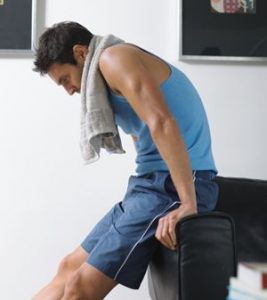Is All Exercise Healthy? A new approach shows promise
by Michael D. Allen, DC, NMD
Functional Neurologist
Is this you?
 Do you feel good after your cardiovascular exercise?
Do you feel good after your cardiovascular exercise?
Upon exertion, does your heart rate jump to your target rate quickly?
Do you sometimes go beyond your target rate just to work a bit harder? Does your heart rate get up to 150-160 beats per minute, and do you try to keep it there for long periods?
Do you huff and puff a lot during your workouts?
Do you start sweating quickly?
Do you keep sweating even after your shower?
Does your heart rate stay up for a while after exercise?
Do you feel a “high” after exercising so hard?
If this sounds like you, read further for more information because what your doctor does not know about you may be important.
We are all individual in our response to exercise, and what your doctor does not know about your unique makeup may end up hurting you.
There are two general types of exercise and both are good for you when they are done at the right time. Aerobic exercise has been shown to stimulate your heart and circulation, improve your functional capacity and reduce the risk of developing type II diabetes. On the other hand, anaerobic exercise develops greater muscle size through resistance training or weight lifting, and increases strength and significantly increases muscle size in the elderly.
The goal of both types of exercise is to increase the number of powerhouses—the “mitochondria”—in your cells. When there are lots of mitochondria, your energy production matches or exceeds your energy needs, and that’s good.
Researchers have found that your mitochondrial endowment comes from your mother, and there are many ways to help you reach your optimal mitochondrial population. Most people use nutritional supplements like lipoic acid, co-enzyme Q10, chromium, etc., but focusing on aerobic exercise is one of the very best ways to get the desired benefits.
The standard formula to determine your target heart rate is 220 minus your age, and then multiply that by 65 and 80 percent to get your heart rate range. The following formula is easier and more specific. It is used by some of the very best and most aerobic athletes.
Try this formula:
1. Subtract your age from 180.
2. Next, subtract one of the following:
a. Subtract 10, if you have been sick or hospitalized in the past year.
b. Subtract 5, if you have suffered with strains and/or sprains, or have not been exercising much in the past 2 years.
c. Subtract 0, if you have been working out for the past year without problems.
d. Add 5, if you are a top performance athlete.
3. Finally, subtract another 10; your optimal heart rate lies somewhere between the numbers you found in steps 2 and 3.
This formula was developed by my friend Phil Maffetone, DC, after his exhaustive study and athletic research. He found this formula to be the cleanest way to calculate the highest level of oxygen metabolism and improve lean body mass while minimizing possible muscle problems.
Give the Maffetone formula a try and see how finding your aerobic heart range works for you.
People often tell me that their aerobic heart rate is way above this calculated level when they exercise. They tell me that if they stayed within these limits they would never feel like they got a workout. I always recommend that they give the Maffetone Method a try. If they will follow these rules it may take two to three months until they realize that their level of exertion has increased while their heart rate stays where it belongs. This whole idea focuses on brain health rather than muscle growth. After all, isn’t overall brain health worth the effort?
Dr. Maffetone has patients who run the equivalent of 2 marathons a day because they can. Others hold very long distance race records. Not that you would do that, but what would you do with that kind of energy?
There are easy tests to check your aerobic performance. Call today to find your functional level and how your mitochondria are doing.



